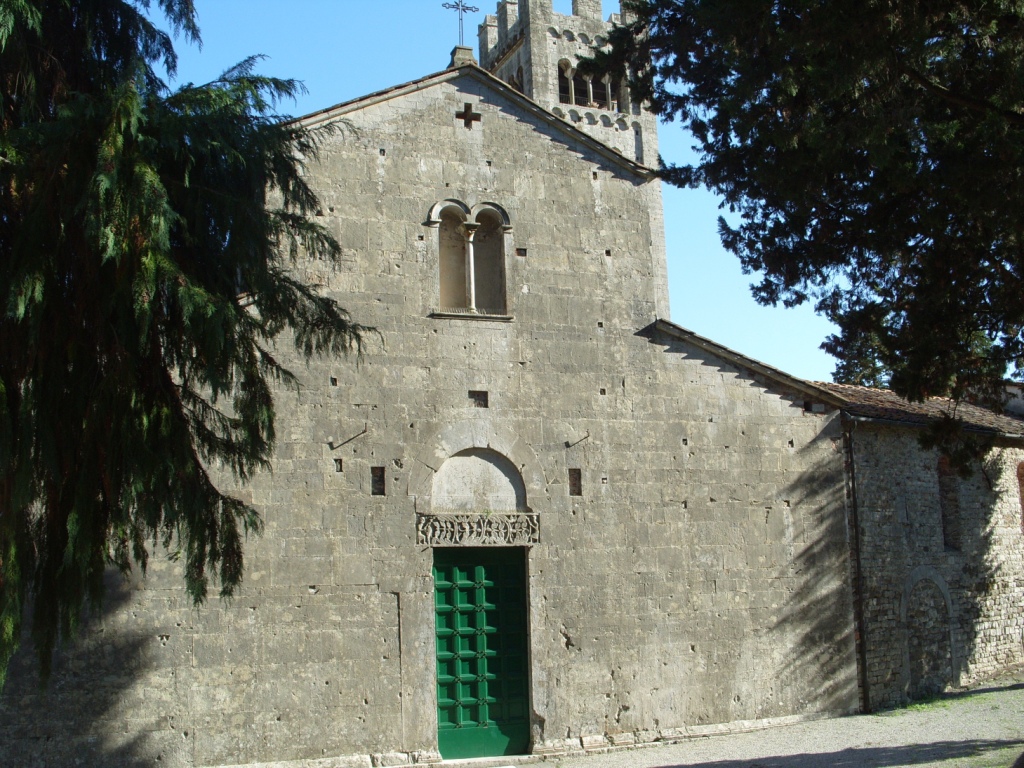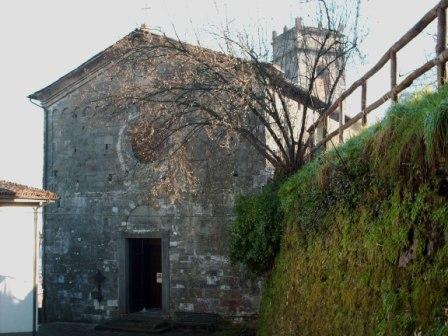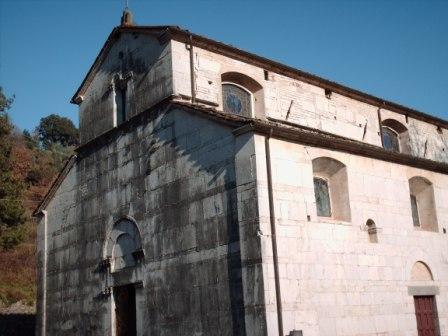 |
 |
|
Tourism
Lucca
city
Province
of Lucca
Castles
|
Romanesque Parishes | Parishes S.Maria Assunta Diecimo (Borgo a Mozzano) S.Giorgio Brancoli (Lucca) S.Jacopo (Gallicano) S.Pietro Valdottavo (Borgo a Mozzano) S.Paolo Vico Pancellorum (Bagni di Lucca) | |
| In the province of Lucca, a lot of Romanesque Parishes exist, more famous, but each of them has contributed through the art and the faith to the cultural and social growth of the territory. For centuries, together with the castles they have represented a point of reference for the populations, that in their greatness and wealth, they identified the power and the importance of his own suburb. The origin of the Parishes is very ancient, in the most greater part it has Roman origins, the same name "parish" it derives from the Latin "plebes." For the Romans, her "plebe" it was formed from the inhabitants of the countries, devoted to the earth's workmanship around the fortitudes, you turn to the control of the territory, at the end of the imperial epoch, "plebes" it became synonymous of "imbelle" (incapable of actions series and dignified), subsequently with the expansion of the Christianity, the community of the baptized ones was pointed out with "parish" ("plebes" it transformed him in "parish" maintaining him disdainful meaning), with the arrival of the Barbarians, the social and administrative structures of the empire collapsed, these centers of command, were replaced with chosen people in the various centers, among the new ecclesiastical hierarchies, these first territories not managed by the empire assumed the name of "parishes." To the arrival of the Longobardis "parishes" taken back the old meaning, the populations were forced to pour taxes and offerings, to the Longobardis (as they did the "plebeian" with the Romans). around the X century, with the union of the two populations, the word "parish" it began to point out the church with the baptismal source, to which they were subject other smaller churches, you build in the near territories | |||
| S.Maria Assunta Diecimo (Borgo a Mozzano) |
 The
Parish of Saint Maria Assunta, in ancient times also devoted to
St. Gervasio, appeared for the first time in a 919 document, but
its origins are a lot older, the church is one of the 28
founded by St. Frediano (the greatest and famous Bishop of
Lucca, who lived in the VI century).
In the XII century, the Countess Matilde of
Canossa, widened the church turning it into a church with three
aisles, making the arcs lean on white and black striped columns
of marble, (typical architecture of the churches Matildiane).
The Parish church of Saint Maria Assunta, is one of the few
churches that have maintained in the centuries, the original
medieval outlay, the façade is embellished by a
architrave,,
a vine-shoot with human figures, attributable to Biduino XII
century.
Its interior has been enriched with different
works of art, among which, a statue representing the prophet
Isaia, with
engraved the motto “Egredietur Virga De Root Iesse”, a slab in
stone, where a rider on horseback is engraved, commonly called “The
King Pipino”, armed with shield
and lance, with the head that leans on the saddle (the stone
probably, broke at the height of the trunk and the head was
redone as best as possible in the little available space).
Two lions (n1-n2)
in stone, belonging perhaps to a pulpit, then demolished
during the centuries is now a tabernacle of holy oils
attributable to the shop of the Civitali
Photos Parish
Source baptismal
Newspaper kiosk church
Bell tower
Roman sarcophagus
Apse
It
walls up external The
Parish of Saint Maria Assunta, in ancient times also devoted to
St. Gervasio, appeared for the first time in a 919 document, but
its origins are a lot older, the church is one of the 28
founded by St. Frediano (the greatest and famous Bishop of
Lucca, who lived in the VI century).
In the XII century, the Countess Matilde of
Canossa, widened the church turning it into a church with three
aisles, making the arcs lean on white and black striped columns
of marble, (typical architecture of the churches Matildiane).
The Parish church of Saint Maria Assunta, is one of the few
churches that have maintained in the centuries, the original
medieval outlay, the façade is embellished by a
architrave,,
a vine-shoot with human figures, attributable to Biduino XII
century.
Its interior has been enriched with different
works of art, among which, a statue representing the prophet
Isaia, with
engraved the motto “Egredietur Virga De Root Iesse”, a slab in
stone, where a rider on horseback is engraved, commonly called “The
King Pipino”, armed with shield
and lance, with the head that leans on the saddle (the stone
probably, broke at the height of the trunk and the head was
redone as best as possible in the little available space).
Two lions (n1-n2)
in stone, belonging perhaps to a pulpit, then demolished
during the centuries is now a tabernacle of holy oils
attributable to the shop of the Civitali
Photos Parish
Source baptismal
Newspaper kiosk church
Bell tower
Roman sarcophagus
Apse
It
walls up external
|
| S.Giorgio Brancoli (Lucca) |
|
|
| Photos Parish Pulpit Baptismal source Bell tower Newspaper kiosk Side external church n°1 - n°2 - n°3 |
| S.Jacopo (Gallicano) |
 The
Parish church of S.Jacopo, was built within the boundary walls of
the castle, around the XII century, to replace the old Parish
church, antecedent to the X century of the saints Cassiano and
Giovanni Battista, situated at around half mile out of the defenses
of the suburb (position that exposed the pilgrims to the risks of
assaults of the brigands) and that in 1359, was definitely abandoned
and subsequently demolished. One of the first documents, that proves
the existence of the church of S.Jacopo, concerns the presbyter
Leopard, which in 1285, together with two other presbyteries, they
appealed to the bishop acting as attorneys of the clergy and of the
churches of Garfagnana, for a tax imposed from the Republic of
Lucca. During the war between Lucca and the heirs of Castruccio,
that involved the castle of Gallicano, the church was violated and
once the rebels had been driven out had to be re-consecrated and
finally, in 1390 the bishop of Lucca, Giovanni III, promoted it to
Parish church. The Parish church, built in the Romanesque style,
with one, single aisle, guards on the inside some important sacred
furnishings, among which, a XIVth century wooden crucifix of the
lucchese school, a wooden statue “The
Madonna with Child” XIV century and an
alter-piece
in glazed terracotta, Robbiana school
of the beginning of the XVI century, representing two angels
crowning the Madonna with Child, among the saints Joseph, Benedict
and Caterina from Alexandria. The
bell tower, has
been raised above a tower, on one
side, under the clock, there is still the existence of two vents,
that were used as a catapult shoot for defence, and on the opposite
part, we find a relief in terracotta, set in memory of
S.Leonardo
from Porto Naurizio
Photos Parish
Central
altar
Baptismal source The
Parish church of S.Jacopo, was built within the boundary walls of
the castle, around the XII century, to replace the old Parish
church, antecedent to the X century of the saints Cassiano and
Giovanni Battista, situated at around half mile out of the defenses
of the suburb (position that exposed the pilgrims to the risks of
assaults of the brigands) and that in 1359, was definitely abandoned
and subsequently demolished. One of the first documents, that proves
the existence of the church of S.Jacopo, concerns the presbyter
Leopard, which in 1285, together with two other presbyteries, they
appealed to the bishop acting as attorneys of the clergy and of the
churches of Garfagnana, for a tax imposed from the Republic of
Lucca. During the war between Lucca and the heirs of Castruccio,
that involved the castle of Gallicano, the church was violated and
once the rebels had been driven out had to be re-consecrated and
finally, in 1390 the bishop of Lucca, Giovanni III, promoted it to
Parish church. The Parish church, built in the Romanesque style,
with one, single aisle, guards on the inside some important sacred
furnishings, among which, a XIVth century wooden crucifix of the
lucchese school, a wooden statue “The
Madonna with Child” XIV century and an
alter-piece
in glazed terracotta, Robbiana school
of the beginning of the XVI century, representing two angels
crowning the Madonna with Child, among the saints Joseph, Benedict
and Caterina from Alexandria. The
bell tower, has
been raised above a tower, on one
side, under the clock, there is still the existence of two vents,
that were used as a catapult shoot for defence, and on the opposite
part, we find a relief in terracotta, set in memory of
S.Leonardo
from Porto Naurizio
Photos Parish
Central
altar
Baptismal source
|
| S.Pietro Valdottavo (Borgo a mozzano) |
 The
Parish church of S.Pietro (a structure with three aisles) was built
following the collapse of a much more ancient church, which already
existed in the castle of “Ottavio” in 725, dedicated to S.Salvatore.
Analyzing the documents in our possession (we find it mentioned for
the first time in a 1260 file). We cannot establish with precision
the exact year that it was built, but doing an analysis of the
structure, we can go back to the XII century. February 4th 1443, the
Parish received from the bishop of Lucca, Nicolao Giunigi, the
Baptismal Font, so escaping from the jurisdiction of the Parish of
Decimo. In the church today, we can admire two Baptismal fonts, one
for “Immersion”
and one "Walled"
probably coming from the old church of S.Salvatore. Following an
earthquake of 1740, there were performed some reparations to the
arches of the spans of the Presbytery, and some years later a side
altar was realized in plaster. In the ‘700’s the Parish was widened
adding the Choir, and between 1839 and 1850 the
bell tower was
built.
Photos Parish
Door
of the church
Capital
Tabernacle The
Parish church of S.Pietro (a structure with three aisles) was built
following the collapse of a much more ancient church, which already
existed in the castle of “Ottavio” in 725, dedicated to S.Salvatore.
Analyzing the documents in our possession (we find it mentioned for
the first time in a 1260 file). We cannot establish with precision
the exact year that it was built, but doing an analysis of the
structure, we can go back to the XII century. February 4th 1443, the
Parish received from the bishop of Lucca, Nicolao Giunigi, the
Baptismal Font, so escaping from the jurisdiction of the Parish of
Decimo. In the church today, we can admire two Baptismal fonts, one
for “Immersion”
and one "Walled"
probably coming from the old church of S.Salvatore. Following an
earthquake of 1740, there were performed some reparations to the
arches of the spans of the Presbytery, and some years later a side
altar was realized in plaster. In the ‘700’s the Parish was widened
adding the Choir, and between 1839 and 1850 the
bell tower was
built.
Photos Parish
Door
of the church
Capital
Tabernacle
|
| S.Paolo Vico Pancellorum (Bagni di Lucca) |
|
|
| Contado Lucchese | Contacts |